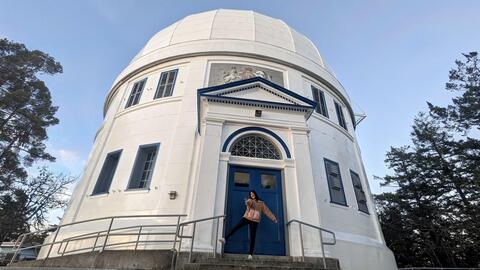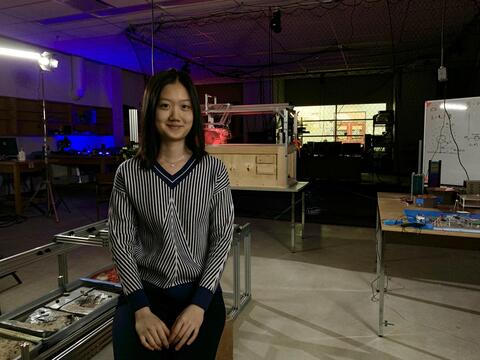Meet Michelle Kao, a 3rd-year Physics & Astronomy student who is nothing short of extraordinary. Many of her instructors remember her as one of the most engaged students in and out of their classes, always asking questions for the pure joy of learning and improving her skills. It is not a surprise that Michelle’s hard work has earned her a Destination Physics Scholarship, awarded to the student with the highest cumulative average in all physics programs within the Department. But as Michelle says, “Grades are not everything – experience is just as important.”
Michelle embodies her philosophy that grades are not the sole measure of success. Rather, it’s the breadth of experiences that shape a well-rounded individual – this is what she has set out to do in her academic and professional career. Actively involved in outreach, Michelle has dedicated herself to initiatives like FemPhys, where she amplifies the voices of underrepresented groups in physics. In her pursuit of diversity in co-op experiences, Michelle effectively transitions between co-op placements in research, industry, and academia, recognizing the value each brings to her personal and professional growth. This commitment to holistic development sets Michelle apart as a dynamic force in both her academic and extracurricular endeavours.
But how did Michelle begin her journey? Born and raised in Kaohsiung, Taiwan, Michelle chose to come to Waterloo so that she could be close to the Perimeter Institute of Theoretical Physics (PI). “I’ve always been drawn to the beauty and mystery of our universe”, Michelle explained. “To explore and seek answers about our cosmos, Perimeter Institute is naturally the place to be.” Her dream was fulfilled when she got to work with Professor Niayesh Afshordi during her first co-op, who is jointly at PI and Waterloo Centre for Astrophysics (WCA). His expertise in a wide range of fundamental physics, from cosmology to quantum gravity, helped guide Michelle toward seeking her interest. When Prof. Afshordi asked Michelle what she wanted to do, Michelle said, “Dark matter sounds fun, and so do black holes.” So a project was created where Michelle would investigate the feasibility of using gravitationally lensed quasar to probe for dark matter microhalos. In other words, attempting to indirectly observe dark matter by seeking its gravitational effect on background light emitted from an accreting supermassive black hole.
Her time at PI opened her eyes to the variety of fascinating theories that cosmology has to offer. But more importantly, she learned that research was nothing like a classroom environment – there were no right or wrong answers. As a result, the experience helped her build more confidence in designing suitable analysis and data visualization to interpret her results. “Prof. Afshordi was very welcoming and encouraging, and gave me so much freedom in my research," Michelle recounted. “His mentorship definitely shaped me into a better independent researcher." Michelle also cherished her time at WCA, where researchers gather to chat about galaxies and the latest discoveries in astrophysics. This gave her insight into what analyzing observational data looks like, and it piqued her interest in experimental and observational research.
 Wanting to work more closely with observational astronomy, Michelle spent her second co-op at NRC Herzberg Astronomy and Astrophysics Research Centre (NRC-HAA) in Victoria, British Columbia. This research institute houses both scientists and engineers, and Michelle got to know a variety of people there who started with astronomy in academia but branched out to work with instrumentation (building telescopes and lenses) or computer science (managing mass astronomy data). When she was at NRC-HAA, Michelle worked with CASTOR (Cosmological Advanced Survey Telescope for Optical and Ultraviolet Research), a Canadian-led flagship space telescope that will not only replace the aging Hubble Space Telescope’s UV capability, but will also cover 100 times its field of view, providing the deepest, widest, and sharpest view of the ultraviolet Universe.
Wanting to work more closely with observational astronomy, Michelle spent her second co-op at NRC Herzberg Astronomy and Astrophysics Research Centre (NRC-HAA) in Victoria, British Columbia. This research institute houses both scientists and engineers, and Michelle got to know a variety of people there who started with astronomy in academia but branched out to work with instrumentation (building telescopes and lenses) or computer science (managing mass astronomy data). When she was at NRC-HAA, Michelle worked with CASTOR (Cosmological Advanced Survey Telescope for Optical and Ultraviolet Research), a Canadian-led flagship space telescope that will not only replace the aging Hubble Space Telescope’s UV capability, but will also cover 100 times its field of view, providing the deepest, widest, and sharpest view of the ultraviolet Universe.
Michelle was responsible for developing software tools for the planning and implementation of CASTOR’s proposed legacy surveys. During her work, she collaborated with Magellan Aerospace to incorporate satellite operations in her calculations for science surveys observing efficiencies. With her work lying at the intersection of space astronomy, satellite engineering, and computer programming, Michelle realized the variety of opportunities the space sector offers. She also gained a deeper appreciation for the instruments and technologies that made collecting astronomy data possible.
 Michelle is now carrying out a more extensive analysis of the space mission scheduling tools with Magellan Aerospace at STARLab, a research laboratory at the University of Manitoba aiming to make space technologies more accessible to communities. Through analysis of spacecraft orbit, attitude control, and the geometry of inertial and moving targets’ locations, Michelle is developing a generic task scheduler that is relevant for a wide range of mission design issues, including the choice and location of ground stations, the performance of satellite communication links, and the design of spacecraft solar arrays. She is also working on optimizing the scheduling algorithm to maximize the mission outputs. Michelle reflects that her current work requires knowledge of computer science, Python coding, and a strong background in math and physics, which an astrophysics student is trained to have.
Michelle is now carrying out a more extensive analysis of the space mission scheduling tools with Magellan Aerospace at STARLab, a research laboratory at the University of Manitoba aiming to make space technologies more accessible to communities. Through analysis of spacecraft orbit, attitude control, and the geometry of inertial and moving targets’ locations, Michelle is developing a generic task scheduler that is relevant for a wide range of mission design issues, including the choice and location of ground stations, the performance of satellite communication links, and the design of spacecraft solar arrays. She is also working on optimizing the scheduling algorithm to maximize the mission outputs. Michelle reflects that her current work requires knowledge of computer science, Python coding, and a strong background in math and physics, which an astrophysics student is trained to have.
I believe the technical skills I gained from astronomy is what helped me take on tasks that require a holistic skill set, and the space sector wants exactly that.
When Michelle completes her third co-op term, her goals are to pursue her interest in space astrophysics, such as analyzing imaging or spectroscopic data from ground or space-based telescopes, while also continuing to explore how astronomers can contribute to the space industry. She is also excited to return to the campus to continue supporting her community through contributions to FemPhys.
Although Michelle has been a powerhouse in academics, she is also very well-known around the department community for her role in FemPhys. From Winter 2022 to Spring 2023, Michelle was a critical member of FemPhys’ relaunch after the pandemic. She helped to host numerous Queer-Trans Science Meetups that bring together 2SLGBTQIA+ individuals to share experiences and a love for science over food and board games. She also helped organize weekly Tea & Talks where people could drop by, enjoy a cup of tea, and make new friends at the cozy FemPhys club room. As a big believer in community building, Michelle advocated to ensure all events were open to all faculties and genders, and to bring people from all areas of physics and related fields to go on nature walks, arts and crafts de-stress events, and educational workshops.
As Michelle continues into the latter half of her degree, she already brings with her a lot of experience and wisdom that makes her an excellent mentor to future students. She is now confident that academia is not the only path for people in Physics & Astronomy, and that it is absolutely crucial to open as many doors of opportunities as you can because everyone’s path may change in the future (whether by choice or by chance). She encourages her peers and all students to “keep an open mind and seek opportunities that help you grow”.




